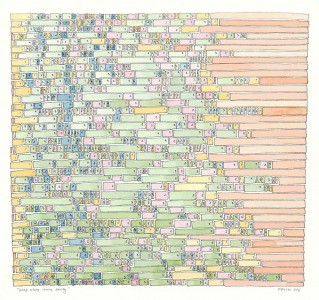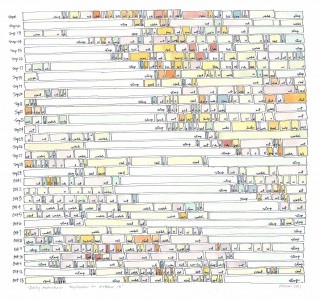Experiments in self-tracking - article in Second Sight
/I met Paul at the Quantified-Self conference last year, and he asked to write an article for Second-Sight in the Netherlands, both a blog and a physical magazine, with a genuine transhumanist orientation....as my friend Adam Curry likes to call me ;-). It captures a little history of the Quantified-Self and sweetly summarizes my Ted talk, and makes a nice post. Thanks Paul! Laurie Frick - Experiments in self tracking | Article in Second Sight magazine June 2013 issue - Paul van den Bosch
Wouldn't you like to get to know yourself better? Laurie Frick does, so she collects metrics of herself and creates hand-built works and installations with beautiful patterns and colorful rhythms. Inspired by neuroscience she uses her work to get a deeper understanding of the nature of pattern and the mind.
As a former executive of a high tech company with a background in high technology and engineering she is no stranger to numbers. After she retired early, 10 years ago, she started a new career, this time as an artist. She now spends most of her time in Austin (Texas) and New York and has been awarded various residencies including one by the UT Neuroscience Imaging Research Center.
Frick became interested in the notion of little bits of time and why we jump from one thing to the next, so she began trying to capture a little diary of how she spent her time. She soon realized it was incredibly difficult to do, so she started measuring her sleep cycles as an easier way to measure how she spent her sleep.
Simultaneously she found Ben Lipkowitz who measured how he spent his minute-by-minute time for the past seven years. At first he just wondered how much time he needed doing the dishes, but this simple measurement evolved into an incredible life-logging project. In Frick’s words “demonstrating the subliminal, underlying metrics of a person, all these measurements became like a data portrait measured and captured of you”. This is how she got involved in the Quantified Self movement. The "Living by Numbers" movement was originally started by Gary Wolf and Kevin Kelly, editors of Wired Magazine. They noticed that a lot of people were measuring certain aspects of their life and thanks to the increased availability of wearable sensors, combined with wearable computing and wireless communication were collecting data about themselves, creating visualizations and looking for meaning in these numbers. People started to meet, explaining what and how they measured themselves.
Currently more than 100 Quantified Self groups exist all over the world. Self tracking has become popular and many devices are available. People use activity trackers such as the Fitbit or Nike+ Fuelband, hook themselves up to sleep monitors, perform biometric measurements, monitor their blood glucose and food intake, and even have their genetic profile mapped. Tracking yourself is no longer limited to making sure you don’t weigh to much, but is becoming a means to learn more about yourself and to collect detailed, objective information about your health.
 Frick started to measure her life in great detail; she recorded how she slept, kept a log of her walking and travel patterns, measured her heart rate, collected speech patterns, made notes of the food she ate, how much time she spent online, and more. Being an artist she then started to work with all these data, trying to make sense of them in a visual way. It is interesting to see how she works, for example how she processed her sleep data into a work of art. She started by measuring her sleep using a Zeo, a device with a headband that measures your EEG and records the sleep state you’re in. She exported the sleep data into an excel sheet and used colors to represent each sleep state. Using these as a starting point she made lots of drawings. She then collected all kinds of pieces of wood that she used to create the final artworks.
Frick started to measure her life in great detail; she recorded how she slept, kept a log of her walking and travel patterns, measured her heart rate, collected speech patterns, made notes of the food she ate, how much time she spent online, and more. Being an artist she then started to work with all these data, trying to make sense of them in a visual way. It is interesting to see how she works, for example how she processed her sleep data into a work of art. She started by measuring her sleep using a Zeo, a device with a headband that measures your EEG and records the sleep state you’re in. She exported the sleep data into an excel sheet and used colors to represent each sleep state. Using these as a starting point she made lots of drawings. She then collected all kinds of pieces of wood that she used to create the final artworks.
The one feature that stands out in her work are the recurring patterns: her idea is that innate patterns of behavior and body function are like an individual fingerprint. Literally everything you start to imagine that can be measured creates a portrait of you. You have an individual rhythm that’s particular to you and it can also reflect who you are. She discovered for example that her sleep patterns are pretty steady. She has a very low standard deviation of her sleep score, versus her husband whose sleep score swings wildly. She realized it was a reflection of both their personalities.
Laurie Frick thinks self-tracking will become invisible, embedded into apps that we use and don’t even think about. Self-tracking data will be pervasive, for example our clothes will have sensors that know how much we moved our arms and legs, and thus will send accurate data about our caloric expenditure to our Fitbit or Nike+ Fuelband dashboard. Our watch will track our heart-ratevariability and give us little stress alerts. Laurie Frick's best fantasy is that all our data will be turned into a patterned wall texture that is spit out from a 3D printer in the walls of our home. It will be recyclable and updatable, giving us feedback about our activities and the changes in our body, allowing us to adjust your behavior and tweak our daily habits. “We will create human data portraits as art on our walls: mindfulness made tangible".
When asked if she thinks her artwork could be a source of inspiration for science, she replies she doesn’t want to presume an artist could have an effect on scientific research. But she mentions an interesting subject. It seems that the work on the human Connectome project to map the pattern of connections in the brain might find there is an innate pattern of you. It’s a rhythm that is inherently familiar and repeats itself in many facets of the person you are. And strangely enough there is a resonance when you encounter those same patterns in the real world. Frick’s art give us an intimate look into her own patterns.
She also thinks big data research teams can learn from artists on how to deliver data that is addictive, beautiful and something you want to look at. Much of the self-tracking data graphics is so literal and dull, that it is hard for the average person to discover any meaning in all those data points. How do you for example determine the relationship between your mood, your physical location and the time of day? But if the visual presentation of data were to be artified, it would make it a lot easier to understand.
Even if science isn't inspired by art Frick’s work shows that art can teach us about ourselves, just as science does. Frick's art reveals a person's innermost patterns and maybe one day we will be gazing at the walls of our living room looking at these beautiful patterns, and gain a deeper understanding of who we are.




